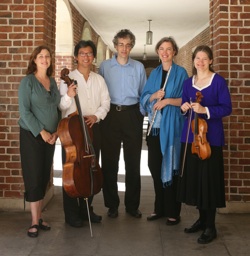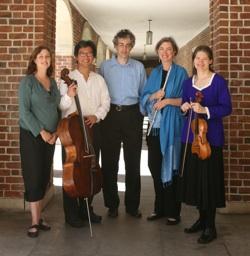
But few ensembles structure seasons that way. I know of only two. One is the Cypress Quartet, now in its 11th year of “Call and Response” programs. The other is Left Coast, whose latest program in this vein I heard at Mill Valley’s Throckmorton Hall on Thursday.
Is it the level of playing that draws composers (so to speak) Left-ward? The vibe? It can hardly be the easy assignments. “We need a companion piece to Beethoven’s Grosse Fuge” sounds like the stuff of composition students’ nightmares.
As it happens, this program was originally designed to premiere “companions” to two works. Melinda Wagner’s work for oboe and strings had to be bumped to April, which left Benjamin Britten’s Op. 2 Phantasy Quartet (for oboe and string trio) rather isolated on an otherwise string-quartet-only program.
Hearing it here, with Tom Nugent’s eloquent oboe on top, reminded me again how polished is even the earliest music Britten decided to publish. A lot of early Britten has come to light in the decades since his death, and all of it is interesting music. But when the man put an opus number to something, it was ready for prime time. Everything in the piece, from the emerging-out-of-nowhere accompaniment right back to the disappearing-back-into-nowhere ending that mirrors it, is calculated, and works. Some people find that level of control off-putting. I can’t help but admire it.
Daunting Challenge
While I am not a composer, I can imagine (just) the task of writing something to stand beside Britten’s Op. 2. Sam Nichols and Kristin Kuster had the nerve-racking task of coming up with a piece to stand alongside the Grosse Fuge. They did it well, in quite different ways. Nichols’ Refuge takes the piece’s weird disjunctures as its conceptual material, and what he builds out of them is wide-ranging and striking (I liked particularly the demented quasi-tango, mostly pizzicato, that emerges a couple of times). Nichols mentions in his program note the idea of lines evolving in slowly different directions, so that they unfold in a kind of fuzzy counterpoint. That music is there, and arresting; yet it’s a small part of an extremely varied piece.Kuster’s Midnight Mirror is another sort of beast. Her own account is vivid. Of the Grosse Fuge, she says that in it Beethoven “celebrates the relentless intensity of time, our enraptured emotionality that’s over in the blink of an eye, our strained and fumbling grip on time, churning, incessant, and ceaseless.” Fair enough.
Kuster’s concrete point of reference in the Beethoven seems to have been that unnerving eruption of trills midway through. A thicket of joyous trills starts her piece, to return later; the violins play long, sinuous lines, over insistent, impetuous music from viola and cello. In proximity to the Grosse Fuge the piece did seem to have almost an indecently optimistic outlook on life; that might have been the point.
And the Grosse Fuge itself? Let’s just say that Stravinsky (who, to be fair, probably knew the piece best through Beethoven’s two-piano version) would never have thought of the piece as “pure interval music” had he heard it played like this. The performance was strenuous to the point of fracture. (Almost literally — the quartet had to stop at one point, and fortunately for the audience it decided to take it from the top.) It wasn’t physical struggle with the notes (well, mostly not), but the kind of engagement with the music that makes players step up to its most extreme demands with deadly seriousness. If there’s a fortissimo on every note, then, by golly, let’s make it fortissimo! I may have heard cleaner, clearer performances, though never one more grippingly communicative, nor one that better conveyed what radical music this is.
If anything was missing, it was that levity that’s the last, most unfathomable thing in late Beethoven. Just when you’ve pegged him as intricate, involuted, and severe, he throws flowers in your face. In the Grosse Fuge, the flowery music, so to speak, first shows itself right after the slow middle section. There’s a lot of mayhem still to come in the piece, yet for a minute or so you sense nothing but rainbows and light, amiable exchanges among players, gracious courtesies all around. The Left Coast players never quite left the old anxiety and intensity behind.

